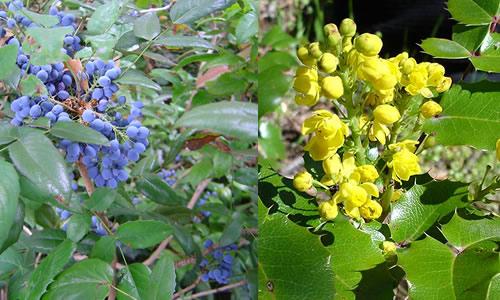
Oregon Grape Designated in 1899
Do you know what the state flower of Oregon is?
It is this beautiful woodland native plant, Oregon Grape, Mahonia aquifolium, that can be found growing along Terwilliger Parkway and throughout most of the city. Oregon designated the Oregon grape blossom as the official state flower in 1899. The following description of this remarkable plant has been adapted from the Portland Nursery website (http://portlandnursery.com/plants/natives/mahonia.shtml).
Of the many species of Mahonia (Berberis), three are abundant in Oregon and throughout the Pacific Northwest: M. aquifolium, M. repens,and M.nervosa. All three are evergreen and have the characteristic holly-like leaf shape, some more pointed and prickly than others. Woody-stemmed and spreading by rhizomes, the new growth in the spring emerges in a light green to soft coppery-red color; at the other end of the year the foliage responds to colder weather by taking on shades of bright red to burgundy - truly lovely in the grayed winter landscape. In mid-spring, the plant is topped with sprays of small bright yellow fragrant flowers in a long-blooming display that attract bees, hummingbirds and other pollinators to the garden.
Following the bloom are clusters of dusky blue, round to oblong berries that are the “grapes” that give it its common name. The berries are edible, though not always palatable, as they are often quite tart. Recipes for jelly usually combine the juice of Oregon grape with that of the sweeter salal berries or apple concentrate. The root has traditional medicinal properties, and along with the yellow inner bark has been used as a dye. There are many sources of information about these uses but here are two at Bosky Dell Natives: Recipes from Bosky Dell Natives and an article by Judy Bluehorse Skelton, herbalist and educator (Thank you to Bosky Dell Natives).
Tall Oregon Grape, Mahonia aquifolium: In general, richly acidic, well-drained soil in partial shade suits these plants best. Because of their long roots, established plants usually don’t survive transplanting very well. However, M. aquifolium can easily withstand the dry shade under large trees, though also tolerant of moist (not wet) conditions. It can grow in full sun, but will suffer if not given some shade where summers are hot, even with more regular water. All in all, a beautiful, adaptable, bird-friendly addition to many garden settings.
Cascade, Long-leaved, or Dull Oregon Grape (Mahonia nervosa): This Oregon grape is lower growing, spreading evergreen shrub, topping out at about two feet. The pale yellow flowers form in long racemes of about eight inches, and the leaves are longer and a grayer-green color than the M. aquafolium. A slower-growing species, it is especially well-suited to areas of dry shade, providing an attractive anchor for the border of a shady garden. Cold weather will turn the leaves a rich wine color, and older leaves often turn a brilliant red before falling off.
Low, or Creeping Oregon Grape (Mahonia repens): The lowest growing of the three, M. repens generally grows to only about a foot in height, with a spread to three feet. The spines on the more rounded leaves are weaker, so not so dangerous to place near a path. A species from east of the Cascades, low Oregon grape will grow happily in full sun to full shade; it is the most successful for perpetually dry shade and once established is drought tolerant even in sunny conditions. Full sun and winter cold give the leaves a bronze cast. A great plant for cover and food for ground-feeding birds. M. repens is considered a noxious weed in other parts of the country, but is fully garden-worthy here in its native range.
